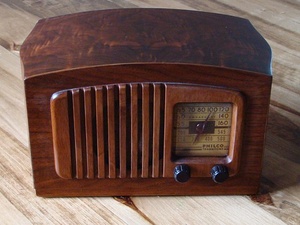Lost in cyberspace: Feds spent $30K to get ad data they couldn’t find at FCC

The FCC needs to modernize its radio political ad data.”Philco radio model PT44 front” by Armstrong1113149 – Own work. Licensed under Public Domain via Wikimedia Commons.
The Federal Communications Commission has begun asking the public to weigh in on whether radio, cable and satellite TV operators should report political ads the way that broadcast TV already does. But for a clear demonstration of just how bad existing data is, the FCC can look to a U.S. Government Accountability Office report released earlier this year.
The government’s spending watchdog gave up even trying to track radio ad spending by issue, concluding there just wasn’t a credible source covering 2007 through 2012.
The point of the report, which was released in September as “Broadcast Television and Radio: Disclosure Requirements for Broadcasted Content” was relatively obscure: track down advertising aired by TV and radio stations promoting their own interests. Though the stations disclose political ads aired by others, they aren’t required to report ads they air on their own behalf, or to air ads with opposing viewpoints.
The proposed rulemaking announced Thursday wouldn’t close the loophole the GAO looked at or alter the rules of reporting. Instead it would compel radio as well as cable, satellite television, and satellite radio to report put their files online via an FCC site.
In spite of the legal ambiguity, many TV stations do disclose their own in-house ad buys–but the GAO was unable to say how many because the records are such a mess, and can be thrown out after just two years.
Instead, the GAO ended up paying $30,000 in taxpayer funds to Kantar Media, an ad-tracking company, for records of TV ads on topics investigators thought would be relevant, according to a copy of the contract requested from GAO. Only the TV data was good enough to use–the report gave up on even tracking radio at all “due to limitations in public and private data sources.”
The first obstacle to using the public data on TV advertising was the time the GAO wanted to examine. The report set out to look at ads aired between 2007 and 2012. But broadcast TV files need only be kept for two years. Moreover, an order to collect these files from the biggest stations in the country began only in August of 2012; prior to that these files were only kept on paper at individual station offices.
When GAO researchers looked further into the issue, things looked worse. The TV files are required for political issue ads “relating to any political matter of national importance, including a national legislative issue of public importance.” But there’s no official guide as to what issues meet this criteria. The GAO report noted “stakeholders we spoke with, including FCC and NAB, told us that broadcasters are responsible for making determinations on a case-by-case basis.”
Even after paying $30,000 for data on ads in four subject areas, GAO still couldn’t produce reliable cost estimates of the ads. That’s in spite of the fact that broadcast TV stations make public the cost of every political ad spot they air–something their lobby, the National Association of Broadcasters, has complained bitterly about.
For radio, less data is available, and the GAO was unable to even find cost estimates. The best information again came from Kantar Media’s Campaign Media Analysis Group (‘CMAG”)–but it had holes. “We determined that CMAG’s radio data were not comprehensive enough for our purposes because these data cover fewer stations in fewer markets than the television data and do not include cost estimates, among other reasons.”

